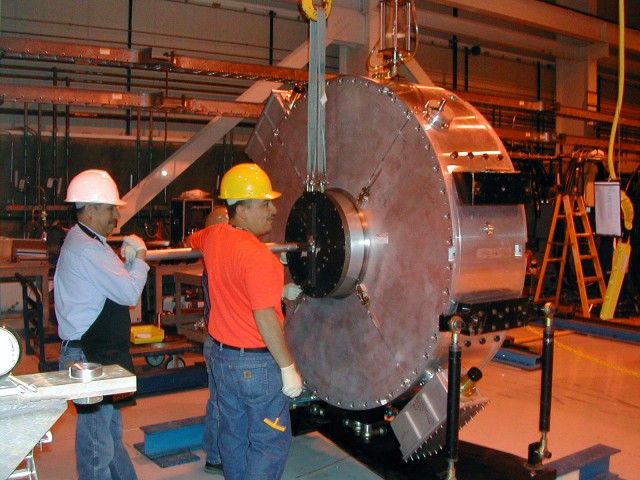AXIS 2 = 4
Laboratory leadership recently witnessed two successful test firings of the Axis 2 accelerator at the Dual Axis Radiographic Hydrotest facility at Technical Area 15. Early data from the roughly half-power tests clearly showed four distinct pulses, each 60 nanoseconds long and 400 nanoseconds apart, just as expected.
Laboratory Director Michael Anastasio and several senior managers watched the test firing from the DARHT accelerator control room. In an enthusiastic exchange of information during the pause between the two firings, Anastasio and the leadership group peppered researchers with technical and programmatic questions, which were eagerly answered.
"This is an exciting first step in proving the capability of DARHT Axis 2, which is such an important part of our stewardship mission," said Anastasio. "After seeing the data firsthand and talking with the DARHT team, I just want to say thank you to everyone involved for the hard work, long hours, steadfast resolve, and technical achievement."
"The large-scale experimental capability at the Laboratory has taken another positive step toward producing 3D, multi-frame radiographs in the future," said Glenn Mara, principal associate director for weapons programs (PADWP). "Clearly, there is much more to be done, but these early results are indicative of the success of stewardship and our continuing progress toward transformation of the weapons complex."
"The team has really pulled together to solve some major technical challenges," said Charles McMillan, associate director for weapons physics (ADWP). "The Axis 2 project is working to implement complex accelerator technology - at a level not done anywhere else in the world - and is now getting excellent results."
Prior to the test firings, Trent McCuistian and the DARHT second axis team, began test firing 8 million electron-volt (MeV) four-pulse electron beams for the first time, getting very good early results, according to Ray Scarpetti, of ADWP, DARHT second axis project director. The accelerator at full power is expected to reach 17-18 million electron volts; that should occur about a year from now in parallel with the continued rebuilding of the remaining accelerator cells that solve a voltage breakdown problem discovered in 2001.
"The results are preliminary, but very encouraging," said Scarpetti. "At 8 MeV, the cells are all working extremely well. With more than 1,000 tests on each individual cell on the test stand and more than 700 test shots on the 26-cell partially rebuilt accelerator, we haven't seen a single voltage breakdown."
Each Axis 2 cell is a 15,000-pound doughnut-shaped aluminum structure, with an internal configuration of magnetic material and insulating oil. At the center of each cell is a high voltage vacuum insulated beamline. The structures allow operators to add voltage in steps to an electron beam, accelerating it to very high energy and eventually slamming it into a target to create x-rays. Electronic detectors turn the x-rays into high-speed images of mock nuclear weapon components at detonation. When complete, Axis 2 will consist of 74 individual accelerator cells.
Laboratory managers called the four-pulse success a major collaborative achievement. Researchers from Lawrence Livermore National Laboratory worked with Los Alamos on developing an electromagnetic "kicker," that chops the long electron beam into four discreet, short pulses, as well as the unique target assembly specially designed to produce four pulses of x-rays modified to yield meaningful data during half-power firings. The primary purpose of these scaled accelerator tests is to understand the physics of the kicker and target to optimize the design to meet the project requirements and goals.
"The real four-pulse success story starts with the cell redesign and rebuild," said Scarpetti. "Once the voltage breakdown problem was diagnosed, the design had to be modified," he said. "The most obvious change was that each cell was made one inch longer in addition, to a whole host of complex technical issues that we solved."
The Laboratory collaborated with scientists at Lawrence Berkeley National Laboratory on cell redesign, with electrical and mechanical redesign at Los Alamos led by Kurt Nielsen and Juan Barraza, respectively, both of DARHT (HX-6). Berkeley Lab also worked on electron injector design, which generates the initial electron beam.
All accelerator cell disassembly, rework and reassembly is undertaken at Los Alamos with disassembly operations at Technical Area 35 in the old ATLAS building, under the supervision of Tim McCurdy of DARHT. Pat Schafstall of DARHT leads the reassembly team at TA-15, in the Radiographic Support Laboratory.
The DARHT project team expects to continue half-energy testing until February 2007 and then will begin installing the remaining complement of accelerator cells and ramp up to full power. The team hopes to conduct its first truly dual-axis hydrotest in early 2009.

